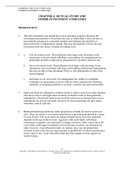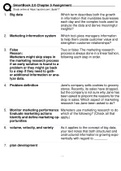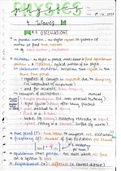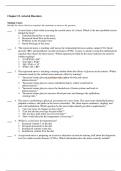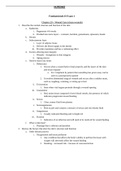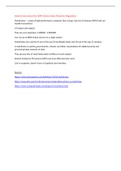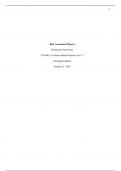CHAPTER 4: MUTUAL FUNDS AND
OTHER INVESTMENT COMPANIES
CHAPTER 4: MUTUAL FUNDS AND
OTHER INVESTMENT COMPANIES
PROBLEM SETS
1. The unit investment trust should have lower operating expenses. Because the
investment trust portfolio is fixed once the trust is established, it does not have to
pay portfolio managers to constantly monitor and rebalance the portfolio as
perceived needs or opportunities change. Because the portfolio is fixed, the unit
investment trust also incurs virtually no trading costs.
2. a. Unit investment trusts: Diversification from large-scale investing, lower
transaction costs associated with large-scale trading, low management fees,
predictable portfolio composition, guaranteed low portfolio turnover rate.
b. Open-end mutual funds: Diversification from large-scale investing, lower
transaction costs associated with large-scale trading, professional management
that may be able to take advantage of buy or sell opportunities as they arise,
record keeping.
c. Individual stocks and bonds: No management fee; ability to coordinate
realization of capital gains or losses with investors’ personal tax situations;
capability of designing portfolio to investor’s specific risk and return profile.
3. Open-end funds are obligated to redeem investor's shares at net asset value and thus
must keep cash or cash-equivalent securities on hand in order to meet potential
redemptions. Closed-end funds do not need the cash reserves because there are no
redemptions for closed-end funds. Investors in closed-end funds sell their shares
when they wish to cash out.
4. Balanced funds keep relatively stable proportions of funds invested in each asset
class. They are meant as convenient instruments to provide participation in a range
of asset classes. Life-cycle funds are balanced funds whose asset mix generally
depends on the age of the investor. Aggressive life-cycle funds, with larger
investments in equities, are marketed to younger investors, while conservative life-
cycle funds, with larger investments in fixed-income securities, are designed for
older investors. Asset allocation funds, in contrast, may vary the proportions
invested in each asset class by large amounts as predictions of relative performance
across classes vary. Asset allocation funds therefore engage in more aggressive
market timing.
4-1
Copyright © 2020 McGraw-Hill Education. All rights reserved. No reproduction or distribution without the prior written consent of
McGraw-Hill Education.
, CHAPTER 4: MUTUAL FUNDS AND
OTHER INVESTMENT COMPANIES
5. Unlike an open-end fund, in which underlying shares are redeemed when the fund
is redeemed, a closed-end fund trades as a security in the market. Thus, their prices
may differ from the NAV.
6. Advantages of an ETF over a mutual fund:
• ETFs are continuously traded and can be sold or purchased on margin.
• There are no capital gains tax triggers when an ETF is sold (shares are just
sold from one investor to another).
• Investors buy from brokers, thus eliminating the cost of direct marketing
to individual small investors. This implies lower management fees.
Disadvantages of an ETF over a mutual fund:
• Prices can depart from NAV (unlike an open-end fund).
• There is a broker fee when buying and selling (unlike a no-load fund).
7. The offering price includes a 6% front-end load, or sales commission, meaning that
every dollar paid results in only $0.94 going toward purchase of shares. Therefore:
NAV $10.70
Offering price = = = $11.38
1 − Load 1 − 0.06
8. NAV = Offering price (1 –Load) = $12.30 .95 = $11.69
9. Stock Value Held by Fund
A $ 7,000,000
B 12,000,000
C 8,000,000
D 15,000,000
Total $42,000,000
$42,000,000 − $30,000
Net asset value = = $10.49
4,000,000
10. Value of stocks sold and replaced = $15,000,000
$15,000,000
Turnover rate = = 0.357, or 35.7%
$42,000,000
4-2
Copyright © 2020 McGraw-Hill Education. All rights reserved. No reproduction or distribution without the prior written consent of
McGraw-Hill Education.
OTHER INVESTMENT COMPANIES
CHAPTER 4: MUTUAL FUNDS AND
OTHER INVESTMENT COMPANIES
PROBLEM SETS
1. The unit investment trust should have lower operating expenses. Because the
investment trust portfolio is fixed once the trust is established, it does not have to
pay portfolio managers to constantly monitor and rebalance the portfolio as
perceived needs or opportunities change. Because the portfolio is fixed, the unit
investment trust also incurs virtually no trading costs.
2. a. Unit investment trusts: Diversification from large-scale investing, lower
transaction costs associated with large-scale trading, low management fees,
predictable portfolio composition, guaranteed low portfolio turnover rate.
b. Open-end mutual funds: Diversification from large-scale investing, lower
transaction costs associated with large-scale trading, professional management
that may be able to take advantage of buy or sell opportunities as they arise,
record keeping.
c. Individual stocks and bonds: No management fee; ability to coordinate
realization of capital gains or losses with investors’ personal tax situations;
capability of designing portfolio to investor’s specific risk and return profile.
3. Open-end funds are obligated to redeem investor's shares at net asset value and thus
must keep cash or cash-equivalent securities on hand in order to meet potential
redemptions. Closed-end funds do not need the cash reserves because there are no
redemptions for closed-end funds. Investors in closed-end funds sell their shares
when they wish to cash out.
4. Balanced funds keep relatively stable proportions of funds invested in each asset
class. They are meant as convenient instruments to provide participation in a range
of asset classes. Life-cycle funds are balanced funds whose asset mix generally
depends on the age of the investor. Aggressive life-cycle funds, with larger
investments in equities, are marketed to younger investors, while conservative life-
cycle funds, with larger investments in fixed-income securities, are designed for
older investors. Asset allocation funds, in contrast, may vary the proportions
invested in each asset class by large amounts as predictions of relative performance
across classes vary. Asset allocation funds therefore engage in more aggressive
market timing.
4-1
Copyright © 2020 McGraw-Hill Education. All rights reserved. No reproduction or distribution without the prior written consent of
McGraw-Hill Education.
, CHAPTER 4: MUTUAL FUNDS AND
OTHER INVESTMENT COMPANIES
5. Unlike an open-end fund, in which underlying shares are redeemed when the fund
is redeemed, a closed-end fund trades as a security in the market. Thus, their prices
may differ from the NAV.
6. Advantages of an ETF over a mutual fund:
• ETFs are continuously traded and can be sold or purchased on margin.
• There are no capital gains tax triggers when an ETF is sold (shares are just
sold from one investor to another).
• Investors buy from brokers, thus eliminating the cost of direct marketing
to individual small investors. This implies lower management fees.
Disadvantages of an ETF over a mutual fund:
• Prices can depart from NAV (unlike an open-end fund).
• There is a broker fee when buying and selling (unlike a no-load fund).
7. The offering price includes a 6% front-end load, or sales commission, meaning that
every dollar paid results in only $0.94 going toward purchase of shares. Therefore:
NAV $10.70
Offering price = = = $11.38
1 − Load 1 − 0.06
8. NAV = Offering price (1 –Load) = $12.30 .95 = $11.69
9. Stock Value Held by Fund
A $ 7,000,000
B 12,000,000
C 8,000,000
D 15,000,000
Total $42,000,000
$42,000,000 − $30,000
Net asset value = = $10.49
4,000,000
10. Value of stocks sold and replaced = $15,000,000
$15,000,000
Turnover rate = = 0.357, or 35.7%
$42,000,000
4-2
Copyright © 2020 McGraw-Hill Education. All rights reserved. No reproduction or distribution without the prior written consent of
McGraw-Hill Education.

